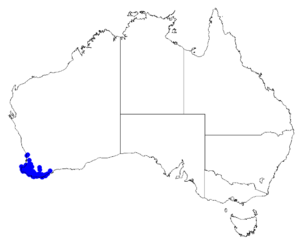Brown boronia facts for kids
Quick facts for kids Brown boronia |
|
|---|---|
 |
|
| Boronia megastigma in the ANBG | |
| Scientific classification | |
 |
|
| Occurrence data from Australasian Virtual Herbarium | |
| Synonyms | |
|
Boronia megastigma, often called brown boronia, sweet-scented boronia, or scented boronia, is a special plant. It belongs to the citrus family called Rutaceae. This plant grows only in the south-west part of Western Australia. It's a tall, thin shrub with leaves and flowers that smell wonderful. Its leaves have three or five small parts. The flowers are shaped like cups, dark brown or purplish-black outside, and bright yellow inside.
What it Looks Like
Boronia megastigma is a shrub that usually grows about 1–2 m (3–7 ft) tall. It has thin branches covered with soft, fine hairs. The leaves are attached directly to the stem (this is called sessile). Each leaf has three or five thin, long parts called leaflets. These leaflets are about 10–20 mm (0.4–0.8 in) long and smell very strong.
The flowers grow one by one where the leaves meet the stem (this spot is called a leaf axil). Each flower hangs down on a small stalk about 10 mm (0.4 in) long. They are cup-shaped and smell amazing. Sometimes, many flowers grow along one branch.
Each flower has four sepals, which are like small leaves that protect the bud. These sepals are smooth and about 2 mm (0.08 in) long. There are also four petals, which are mostly round. They are 6–7 mm (0.2–0.3 in) long. The outside of the petals is reddish-brown to dark brown or purplish-black. The inside is yellow. Sometimes, the outside can be yellow too!
Inside the flower, there are eight stamens. These are the parts that make pollen. The stamens near the sepals have a dark purple top (called an anther) that is about 1 mm (0.04 in) long. These anthers are usually sterile, meaning they don't produce useful pollen. The stamens near the petals have similar anthers, but they are pale yellow and can produce pollen. The stigma, which is the part that receives pollen, is unusually big and dark purple or black. It has four sections.
How it Got its Name
The plant Boronia megastigma was first officially described in 1848. This was done by a scientist named Friedrich Gottlieb Bartling. His description was published in a book called Plantae Preissianae.
The second part of its scientific name, megastigma, comes from old Greek words. Mega means "large" or "great." Stigma refers to the stigma of a flower. So, the name megastigma means "large stigma," which describes the plant's unusually big stigma.
Where it Grows
Brown boronia likes to grow in wet areas like swamps and woodlands during winter. You can mostly find it in the karri forests and the southern parts of the jarrah forests. These areas are located between the towns of Harvey and Cape Riche in Western Australia.
How People Use It
This plant is one of several types of Boronia that people grow because of its strong, lovely smell. It's the main Boronia plant used to get essential oils. These oils are used in perfumes and to make food taste better, especially fruit flavors. Another related plant, Boronia heterophylla, is often picked for its scent and used as a cut flower.
All parts of the boronia flower that produce oil are very active when the stigma is ready to receive pollen. This suggests that the plant makes its strong scent to attract insects, which help with pollination.
There are different types of cultivated brown boronia plants. These types have flowers with various colors. The two main chemicals that give the oil its smell are called β-ionone and dodecyl acetate.
In the past, too many brown boronia plants were picked from their natural homes in Southwest Western Australia. This made people rethink how much of the plant should be harvested from the wild. Now, brown boronia is also grown on farms and in gardens outside of its natural areas.
See also
 In Spanish: Boronia megastigma para niños
In Spanish: Boronia megastigma para niños

